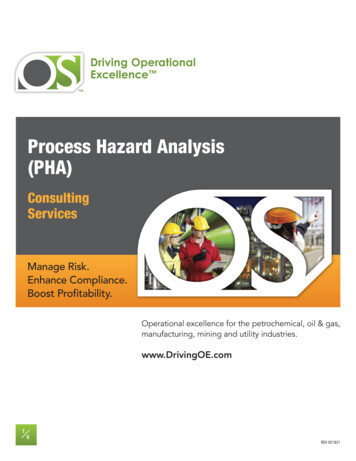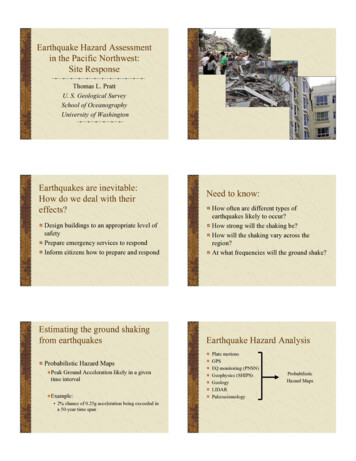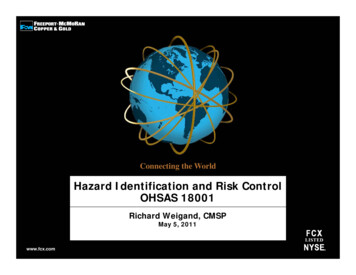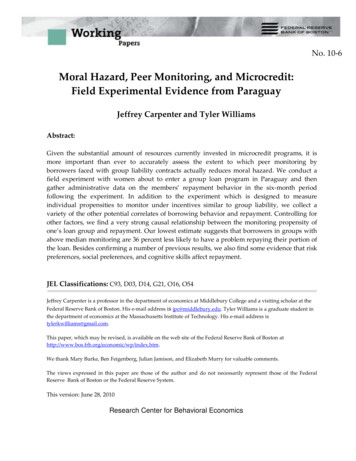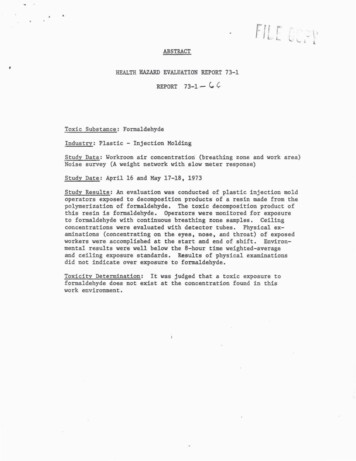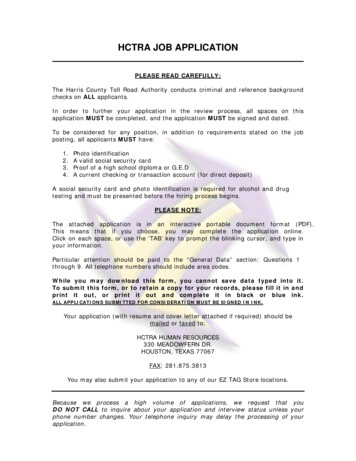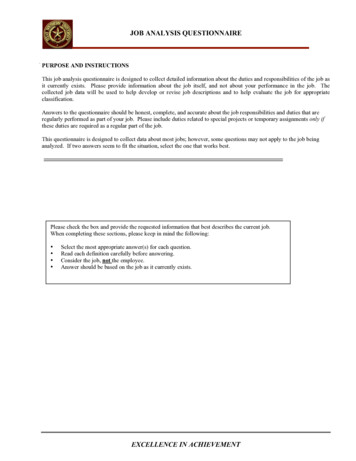
Transcription
Volume 3 1 2019, 55-61DOI: 10.30546/2523-4331.2019.3.1.55International Journal of Humanitiesand Social Development ResearchAPPLICATION OF JOB HAZARD ANALYSIS (JHA)ON WELDING PROCESS INSIDE REACTOR UNITHakan ERDOGANEsenyurt University, TurkeyAbstract.Every day many workers are injured and killed at the workplace. Job HazardAnalysis (JHA) helps to analysis to eliminate and prevent hazards. This is likely toresult reducing of injuries and illnesses; safer, more effective work methods; reducedworkers' compensation costs; and increased worker productivity. JHA is also useful fortraining new employees in the steps required to perform their jobs safely. JHA isapplied , accidents or near-accidents have occurred, one or more of those involved inthe job are not familiar with all hazards and/or how to protect against these hazards, Anew team of workers are working together, safe execution of the work requires closecooperation and coordination between several people and new equipment or newprocesses are being introduced.This study aimed to show elimination of hazards on welding process using JHA . Itprovides to help incidents and possible accidents.Keywords: Safety, job, job safety analysis, hazards, welding55
56Hakan ERDOGAN1. IntroductionJob Hazard Analysis (JHA) is a method of analysis towards potential hazards inworking place by analizing working system and working procedure as well as human asthe workers [ 1 ]. It is a technique that focuses on job tasks as a way to identify hazardsbefore they occur. It focuses on the relationship between the worker, the task, the tools,and the work environment. One of the best ways to determine and establish proper workprocedures is to conduct a job hazard analysis. A job hazard analysis is one componentof the larger commitment of a safety and health management system [ 2 ].The JHA provides the basic methodology and structure needed to find out hazards. JHAapplication will enhance an organization’s evaluation of hazards and their associatedrisks and should be an essential fundamental part of any safety process [ 3 ]. JHArequires supervisors to devote time to see work areas and to observing workers work. Itis multistep process designed to study and analyse a task then break down that task intosteps which provide a means of eliminating associated hazards [ 4 ].The first step in preparing to conduct a JHA is to review all of the jobs in the workplaceand make a list of those jobs that might require a JHA. The method uses a techniqueknown as the SREDIM principle:Select (work to be studied)Record (how work is done)Examine (the total situation)Develop (best method for doing work)Install (this method into the company’s operations)Maintain (this defined and measured method) [ 5 ].The basic procedure for job safety analysis is as follows:1 Select the job to be analysed. (SELECT)2 Break the job down into its component parts in an orderly and chronological sequenceof job steps. (RECORD)3 Critically observe and examine each component part of the job to determine the riskof accident. (EXAMINE)4 Develop control measures to eliminate or reduce the risk of accident. (DEVELOP)5 Formulate written and safe systems of work and job safety instructions for the job.(INSTALL)6 Review safe systems of work and job safe practices at regular intervals to ensure theirutilisation. (MAINTAIN)JHA record chart uses for welding process shown at Table .1
Application of Job hazard analysis (JHA) on Welding process .57Table 1 : JHA record chartJob Hazard Analysis Record ChartJob:Analysed by:Reviewed byApproved by:Sequence of TasksPotential HazardsDate:Date:Date:Preventive MeasuresJHA will include past accident and loss experience, maximum potential loss, probabilityof recurrence, legal requirements, the newness of the job and the number of employeesat risk.2.Material and MethodIn this study we use JHA for welding process in reactor unit at PropaneDehydrogenation Unit (PDH). PDH is an industrial project in Tobolsk /Russia. It hascontained earthworks infrastructure, construction, steel structures, mechanical andcommissioning works (Figure 1) [ 6 ].Figure 1 : Propane Dehydrogenation Unit (PDH) in Russia
58Hakan ERDOGANJHA Prerequisites are :1. Establish JHA team2. Select, define, and delimit the job to be analysed3. Collect necessary background information4. Select a suitable JHA worksheetJobs with the worst accident history have priority and should be analysed first.Accident frequency: A job that has repeatedly caused accidents is a candidate for animmediate JHA.Accident severity: Every job that has produced a lost time injury (LTI) or requiredmedical treatment should be analysed.Accident potential: Every job with a potential for a severe accident should be analysedNew jobs, non-routine jobs, or job changes: These are also prime candidates for JHA.Routine jobs: Routine jobs with inherent hazards that the worker is exposed to.The following information about the job should be provided:- A summary description of the job and the purpose of the job.- A preliminary job review (e.g., observation of the job and the location made by theteam leader). The review report may preferably be supplemented by photos and video.- A listing of required training for access to the work location, to operateequipment/vehicles, to work at heights, etc.-A listing of required/recommended personal protective equipment against hazardswhen performing the job in the specified location.Before the analysis is started, collection of information may be necessary- Interviews- Written procedures- Manuals- Observation of execution of work steps- Review of reports from accidents and incidentsJHAs should be a team effort and normally involve more than one person. The mostexperienced person who performs that job should be on the team. This person has themost familiarity with the job, how it is performed, and any hazards associated with thejob [7].For our work JHA team has consisted as shown tableTable 2: JHA team membersTeam leaderSecretaryTeam membersHakan ErdoganRita GlatmanYılmaz SimsekTufan IsmailogluYusuf DulgerHSE ManagerOffice staffHSE InspectorHamit CanpolatWelding foreman
Application of Job hazard analysis (JHA) on Welding process .59Before welding process in reactor unit, JHA team considered to methodology. Weldingprocedures, legal regulations, interview with welding workers, review of reports fromaccidents and incidents are reconnoitred. After analysed, we have gotten table 3.Table 3: Definition of basic welding hazards with using JHA chartJobAnalysed byReviewed byApproved bySequence ofTasksHotWorkand rocessesHotWorkand rocessesJob Hazard Analysis Record Chart: Welding process inside reactor unit: JHA team membersDate: 11.09.2013: Can AydinDate: 12.09.2013: Ozgur AyavefeDate: 16.09.2013PotentialPreventive MeasuresHazards-Using suitable welding shields and goggles- Suitable fire resistant overalls andg loves are provided andused to protect the skin against burns from hot surfaces,flames, sparksand uv radiation.- Working combustible materials and waste are kept incovered containers.- Welding benches are constructedfrom non-flammable andheat resistant material to prevent fires.Fireand - Know where the fire alarms and extinguishers are located,explosionsand check the extinguisher’s gauge to make sure it is full.- Welding area is restricted to authorized and qualifiedpersons only.- All workers are provided with and use a flexible extractionarm for welding activities.- Gas cylinders are securely stored in a designated area.- Gas welding torches and hoses and regularly checked andmaintained to comply with russian standards.-Welding equipments and grounding circuits are checked andtested regularly .- Welding operators should wear dry gloves in goodcondition, never touch the electrode or metal parts of theelectrode holder with skin or wet clothing and be sure toElectricinsulate themselves from the work and ground, keeping dryShockinsulation between their body and the metal being welded orground (such as a metal floor or wet surface).- Welding operators also should inspect the electrode holderfor damage before beginning to weld and keep the weldingcable and electrode holder insulation in good condition,because the plastic or fiber insulation on the electrode holderprevents contact with the electrically “hot” metal parts inside.- Welding areas require adequate ventilation and localexhaust to keep fumes and gases from the breathing zone andthe general area.
60Hakan ERDOGANHotWorkand rocessesWorkplaceand WorkingEnvironmentHumanFactorsFumes andgasesFalls, Slipsand TripsUnsafe actunsafePractices- Hazardous substances are used incompliance with MSDS.- All welding operators should be aware that there areACGIH threshold limit values (TLV) and OSHA permissibleexposure limits (PEL) for the substances inwelding fume.- To prevent exposure from coatings such as paint,galvanizing, or metal platings on base metals, clean the basemetal before beginning to weld.-Housekeeping is done on a daily basis to prevent thewalkways from being obstructed.- Spills or leaks are dealt with promptly.- Storage area is separated from the workspace- Only people who are adequately trained or are experiencedand deemed as competent .- Personal Protective Equipment is provided and instructionson how to use them is provided as easily understood, as wellall workers are trained in its proper use.- Reactor is locked when not in use and only accessed byauthorised personnel who control the keys to the reactor.- electrical power is isolated when workshop is closed andmachinery controlled by keys.- Avoid rolling up sleeves or pant cuffs, as sparks or hotmetal will deposit in the folds and may burn through thematerial. Keep pants over the top of work boots – don’t tuckthem in.- Helmets with side shields are essential for protecting eyesand skin from exposure to arc rays. Make sure to choose theright shade lens for your process – use the helmet’sinstructions to help select the right shade level.- To protect ears from noise, wear hearing protection ifworking in an area with high noise levels. Doing so willprotect your hearing from damage, as well as well preventmetal and other debris from entering the ear canal. Chooseear plugs or ear muffs to protect the ears.3. Discussion and resultsJHA ensure safe steps, teaches new workers, eliminates or controls hazardous materials.It is basic approach to developing incident prevention procedures. It can be a basicelement in a safety program and the most effective safety programs are those thatinvolve workers [8]. Supervisors can use the findings of a job hazard analysis toeliminate and prevent hazards in their workplaces. This is likely to result in fewerworker injuries and illnesses; safer, more effective work methods; reduced workers'compensation costs; and increased worker productivity [9].
Application of Job hazard analysis (JHA) on Welding process .61For a job hazard analysis to be effective, management must demonstrate its commitmentto safety and health and follow through to correct any uncontrolled hazards identified.Otherwise, management will lose credibility and employees may hesitate to go tomanagement when dangerous conditions threaten them.During the job review process, we especially focused on identifying hazardousconditions and unsafe behaviours. Identification of hazards in welding process providedto eliminate possible accidents during operations. if safety measures are ignored,welders face an array of hazards which can be potentially dangerous, including electricshock, fumes and gases, fire and explosions and more. Using JHA minimizes unsafeconditions and unsafe acts. After defined hazards, temporary and permanentprecautions were taken. Proper personal protective equipment (PPE) are suppliedagainst hazards of welding process inside reactor unit. All PPE are inspected beforegiven workers.Welding workers are also trained about how work inside reactor unit. Allhazards and precautions are taught.References and notes:Muhammad Arif, Gerry Silaban, Isyatun Mardiah Syahri, ‘’Analisa Potensi Bahaya denganMenggunakan Metode Job Safety Analysis (JSA) pada Proses Coal Chain diPertambangan Batubara X Tahun 71.pdf, accessed March 6, 2019.James Roughton, Nathan Crutchfield, ‘’ Job Hazard Analysis: A guide for voluntary complianceand beyond’’Swartz George, Job hazard analysis . Professional Safety; Des Plaines Vol. 47, Iss. 11, (Nov2002): 27-33.John Ridley and John Channing ,’’Safety at Work ‘’ Sixth ne-dehydrogenation-unit-pdh-tobolsk/,accessedMarch 6, 2019.https://www.rit.edu/ w-outrea/OSHA/documents/Module2/M2 JHA.pdf, accessed March 6,2019.Charles D. Reese, ‘’Occupational Health and Safety Management: A Practical y-analysis-jsa-safety-index/, accessed March 6, 2019.
Before welding process in reactor unit, JHA team considered to methodology. Welding procedures, legal regulations, interview with welding workers, review of reports from accidents and incidents are reconnoitred. After analysed, we have gotten table 3. Table 3: Definition of basic welding hazards with using JHA chart Job Hazard Analysis Record Chart


